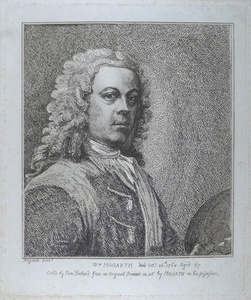| Method | Etching |
| Artist | Samuel Ireland after William Hogarth |
| Published | [n.d.c.1786] |
| Dimensions | Image 200 x 180 mm, Plate 245 x 204 mm, Sheet 256 x 215 mm |
| Notes |
An etched portrait of William Hogarth holding a palette after a self portrait of the artist. Ireland etched a reduced version of this portrait for a frontispiece to volume I of his 'Graphic Illustrations of Hogarth' (O'Donoghue 34). Inscription below image reads: died Oct: r 26th. 1764. Aged 67 Etch'd by Sam.l Ireland from an Original Portrait in oil by Hogarth in his possession Samuel Ireland (1744-1800) was a British author, collector and etcher. He began as a weaver in Spitalfields, then turned engraver and print dealer, and became a fanatical collector. His son William Henry Ireland perpetrated a famous Shakespeare forgery. William Hogarth (1697 - 1764) was born in London, the son of an unsuccessful schoolmaster and writer from Westmoreland. After apprenticeship to a goldsmith, he began to produce his own engraved designs in about 1710. He later took up oil painting, starting with small portrait groups called conversation pieces. He went on to create a series of paintings satirising contemporary customs, but based on earlier Italian prints, of which the first was The Harlot's Progress (1731), and perhaps the most famous The Rake's Progress. His engravings were so plagiarised that he lobbied for the Copyright Act of 1735 as protection for writers and artists. During the 1730s Hogarth also developed into an original painter of life-sized portraits, and created the first of several history paintings in the grand manner. O'Donoghue 33. Ex.Col.: William Bell Scott. Collector's mark and manuscript (Lugt 29474) on verso. Condition: Light foxing to edges of sheet. Window mounted to album page, |
| Framing | unmounted |
| Price | £180.00 |
| Stock ID | 37344 |

